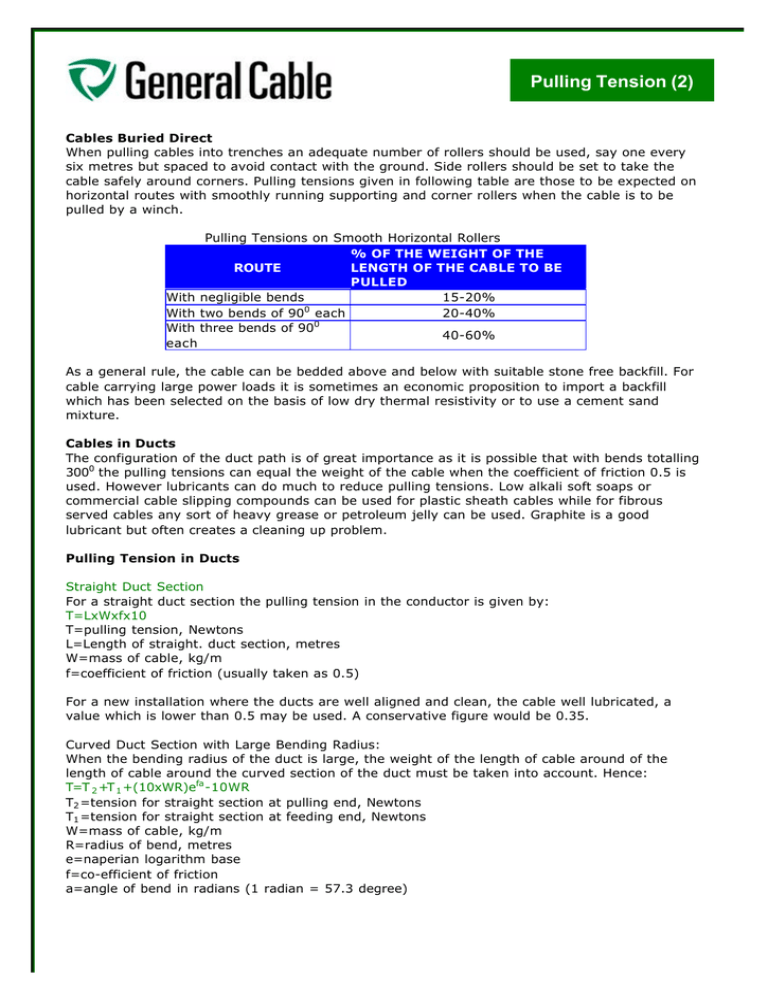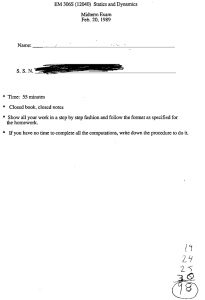
Pulling Tension (2)
Cables Buried Direct
When pulling cables into trenches an adequate number of rollers should be used, say one every
six metres but spaced to avoid contact with the ground. Side rollers should be set to take the
cable safely around corners. Pulling tensions given in following table are those to be expected on
horizontal routes with smoothly running supporting and corner rollers when the cable is to be
pulled by a winch.
Pulling Tensions on Smooth Horizontal Rollers
% OF THE WEIGHT OF THE
ROUTE
LENGTH OF THE CABLE TO BE
PULLED
With negligible bends
15-20%
0
With two bends of 90 each
20-40%
With three bends of 900
40-60%
each
As a general rule, the cable can be bedded above and below with suitable stone free backfill. For
cable carrying large power loads it is sometimes an economic proposition to import a backfill
which has been selected on the basis of low dry thermal resistivity or to use a cement sand
mixture.
Cables in Ducts
The configuration of the duct path is of great importance as it is possible that with bends totalling
3000 the pulling tensions can equal the weight of the cable when the coefficient of friction 0.5 is
used. However lubricants can do much to reduce pulling tensions. Low alkali soft soaps or
commercial cable slipping compounds can be used for plastic sheath cables while for fibrous
served cables any sort of heavy grease or petroleum jelly can be used. Graphite is a good
lubricant but often creates a cleaning up problem.
Pulling Tension in Ducts
Straight Duct Section
For a straight duct section the pulling tension in the conductor is given by:
T=LxWxfx10
T=pulling tension, Newtons
L=Length of straight. duct section, metres
W=mass of cable, kg/m
f=coefficient of friction (usually taken as 0.5)
For a new installation where the ducts are well aligned and clean, the cable well lubricated, a
value which is lower than 0.5 may be used. A conservative figure would be 0.35.
Curved Duct Section with Large Bending Radius:
When the bending radius of the duct is large, the weight of the length of cable around of the
length of cable around the curved section of the duct must be taken into account. Hence:
T=T 2 +T 1 +(10xWR)efa -10WR
T2 =tension for straight section at pulling end, Newtons
T1 =tension for straight section at feeding end, Newtons
W=mass of cable, kg/m
R=radius of bend, metres
e=naperian logarithm base
f=co-efficient of friction
a=angle of bend in radians (1 radian = 57.3 degree)
Value of efa for some common angles are shown in below:
Value Of efa
ANGLE OF
BEND
DEGREES
15
30
45
60
75
90
f=0.7
f=0.6
f=0.5
f=0.4
f=0.3
1.20
1.44
1.73
2.08
2.50
3.00
1.17
1.37
1.60
1.87
2.19
2.57
1.14
1.3
1.48
1.68
1.92
2.19
1.11
1.23
1.37
1.52
1.69
1.87
1.08
1.17
1.27
1.37
1.48
1.60
Curved Duct Section With Small Bending Radius:
When the bending radius of the duct is small the weight of the cable around the curved section of
the duct may be ignored. The above equation is reduced to:
T=T 2 +T 1efa Newton
Immediately prior to the pulling of cable, ensure that the conduit is clean and free of dirt, stones,
water, scale or similar substances.
Tension at bends to limit sidewall pressure to safe level = 3,725R where R is in metres.
If it is necessary to pull cable in very cold weather, the minimum installation temperature of the
cable should be observed. Extra care in handling should be exercised and, in some cases, preheating of the cable may be desirable immediately before pulling.
Cable should be pulled into ducts at a constant speed throughout the entire pull. The cable should
not be allowed to stop midway through the pull; the drag due to friction is greatly increased when
pulling is restarted. The recommended speed is 10-20 m/minute. If this speed cannot be
achieved, the minimum speed of 5 m/minute should be maintained.
When a long length of cable is pulled in a duct where maximum tension would be exceeded, it is
necessary to use caterpillar type cable helpers or similar equipment at the entrance to the duct
system and in extreme cases in pits along the duct run.
Pulling tensions at all times should be restricted to 20kN for duct installations.
With many duct runs there is a preferred end at which the drum should be set up. As a rule of
thumb this should be at the end nearest the sharpest bend. A worked example is given for the
duct configuration shown in following figure pulling from end A, the end closer to the first bend,
and the alternative pulling from end F.
500mm2 copper conductor, XLPE insulated, heavy duty copper wire screened and heat resistant
PVC sheathed single core 19/33kV cable with an overall diameter of 58mm and a mass of 7.14kg
per metre.
The maximum tension T m with pulling eye attached to conductor = 35,000N (limited to 20kN) or
with stocking over PVC sheath=16,800N.
Assume coefficient of friction f=0.5
Pulling from A to F:
Tension
Tension
Tension
Tension
Tension
at
at
at
at
at
B(T1 ) = 20x7.14x0.5x10 =714N
C(T2 ) = T1 efa =714x1.92 =1370N
D(T3 ) = T 2 +60x7.14x0.5x10 =3510N
E(T4 ) = T3 efa = 3.510x1.14 =4000N
F(T 5 ) = T4 +70x7.14x0.5x10 =6500N
Pulling from F to A:
Tension at E(T1 ) = 70x7.14x0.5x10 =2500N
Tension at D(T2 ) = T 1 efa =2500x1.14 =2850N
Tension at C(T3 ) = T2 +60x7.14x0.5x10 =4990N
Tension at B(T4 ) = T3 efa = 4990x1.92 =9580N
Tension at A(T5) = T4 +20x7.14x0.5x10 =10300N
Maximum pulling tension (limited by side wall pressure) around bend B-C; 3725*radius of bend in
metres=3,725x3 =11,200N.
Maximum pulling tension (limited by side wall pressure) around bend D-E; 3725*radius of bend in
metres=3,725x2 =7,450N.
The example illustrates a number of points:
• Feeding from A, the end closest to the first bend requires much less tension than feeding
from end F.
• With the pulling eye attached to the conductor or with a stocking grip over the PVC sheath,
the cable may be pulled from either end as the pulling tension around each bend and the
exit tensions at A & F are below the recommended relevant maximum values.
General Cable New Zealand
HEAD OFFICE
75-89 Main South Rd
PO Box 8044
Riccarton
Christchurch
Ph: (03) 348 5199
Fax: (03) 348 2009
Website: www. generalcable.co.nz
General Cable Australia Pty Ltd
Sales:
1300 363 282
Fax:
1300 363 382
www.generalcable.com.au
Diagrams of cables are illustrative only and are not necessarily to scale.
This brochure is distributed with the understanding that the authors and editors are not responsible for the results of any actions taken on the basis of information in this work , or any errors or omissions.
Further, General Cable is not engaged in rendering professional services. General Cable expressly disclaims all and any liability to any person in respect of anything and of the consequences of anything done
or omitted to be done by any such person in reliance whether whole or partial of the whole or any of the contents of this publication. All rights reserved. No part of this work covered by copyright may be
reproduced or copied in any form or by any means without the written permission of General Cable.




